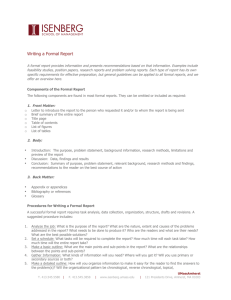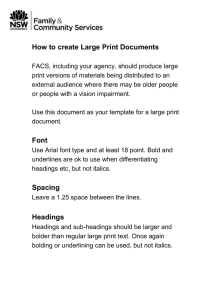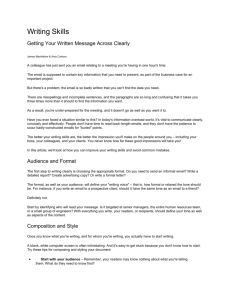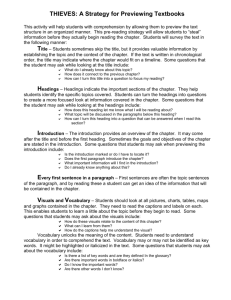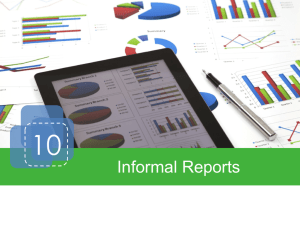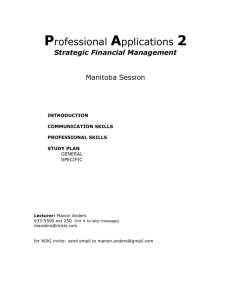Considerations in Writing Reports
advertisement
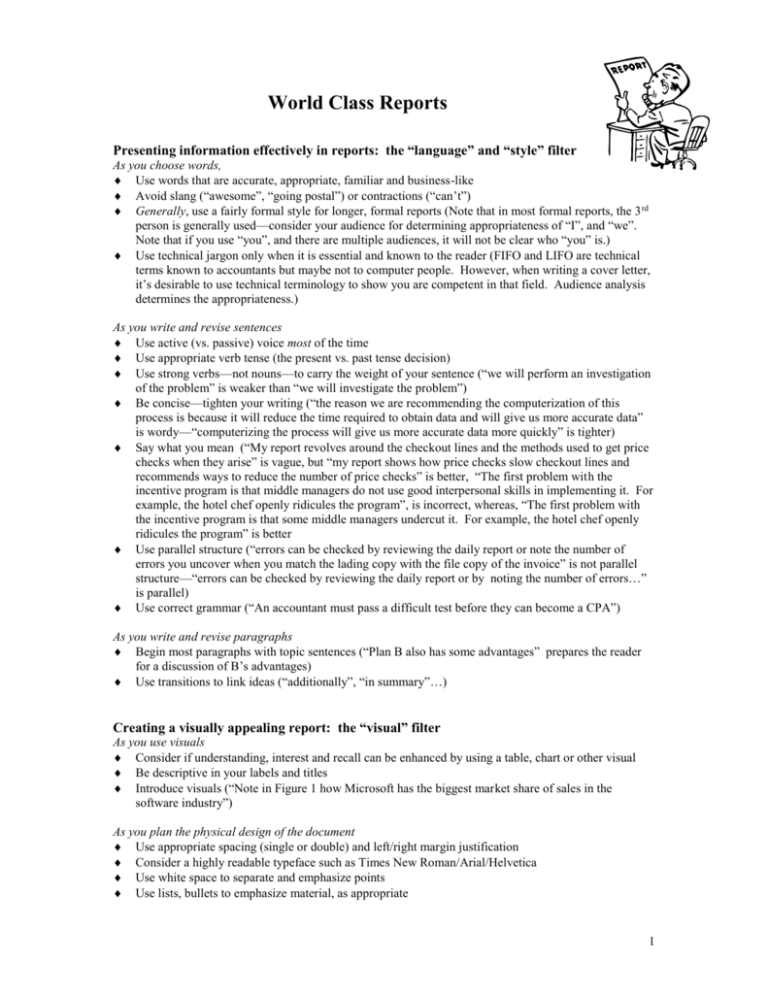
World Class Reports Presenting information effectively in reports: the “language” and “style” filter As you choose words, Use words that are accurate, appropriate, familiar and business-like Avoid slang (“awesome”, “going postal”) or contractions (“can’t”) Generally, use a fairly formal style for longer, formal reports (Note that in most formal reports, the 3 rd person is generally used—consider your audience for determining appropriateness of “I”, and “we”. Note that if you use “you”, and there are multiple audiences, it will not be clear who “you” is.) Use technical jargon only when it is essential and known to the reader (FIFO and LIFO are technical terms known to accountants but maybe not to computer people. However, when writing a cover letter, it’s desirable to use technical terminology to show you are competent in that field. Audience analysis determines the appropriateness.) As you write and revise sentences Use active (vs. passive) voice most of the time Use appropriate verb tense (the present vs. past tense decision) Use strong verbs—not nouns—to carry the weight of your sentence (“we will perform an investigation of the problem” is weaker than “we will investigate the problem”) Be concise—tighten your writing (“the reason we are recommending the computerization of this process is because it will reduce the time required to obtain data and will give us more accurate data” is wordy—“computerizing the process will give us more accurate data more quickly” is tighter) Say what you mean (“My report revolves around the checkout lines and the methods used to get price checks when they arise” is vague, but “my report shows how price checks slow checkout lines and recommends ways to reduce the number of price checks” is better, “The first problem with the incentive program is that middle managers do not use good interpersonal skills in implementing it. For example, the hotel chef openly ridicules the program”, is incorrect, whereas, “The first problem with the incentive program is that some middle managers undercut it. For example, the hotel chef openly ridicules the program” is better Use parallel structure (“errors can be checked by reviewing the daily report or note the number of errors you uncover when you match the lading copy with the file copy of the invoice” is not parallel structure—“errors can be checked by reviewing the daily report or by noting the number of errors…” is parallel) Use correct grammar (“An accountant must pass a difficult test before they can become a CPA”) As you write and revise paragraphs Begin most paragraphs with topic sentences (“Plan B also has some advantages” prepares the reader for a discussion of B’s advantages) Use transitions to link ideas (“additionally”, “in summary”…) Creating a visually appealing report: the “visual” filter As you use visuals Consider if understanding, interest and recall can be enhanced by using a table, chart or other visual Be descriptive in your labels and titles Introduce visuals (“Note in Figure 1 how Microsoft has the biggest market share of sales in the software industry”) As you plan the physical design of the document Use appropriate spacing (single or double) and left/right margin justification Consider a highly readable typeface such as Times New Roman/Arial/Helvetica Use white space to separate and emphasize points Use lists, bullets to emphasize material, as appropriate 1 Use headings to group points (Attention to: being consistent in placement, being descriptive in phrasing, using the same grammatical structure—compare the following: These headings are not parallel: Are students aware of VIP? Current Awareness among Undergraduate Students Graduate Students These are parallel: Campus Awareness of VIP Current Awareness among Undergraduate Students Current Awareness among Graduate Students Using proper report form (for longer reports): the “form” filter Report cover Title page (Includes: title of report, for whom the report is prepared, by whom it is prepared, release date. If the title does not contain the recommendation, it normally indicates what problem the report tries to solve: Ways to Market Communication Consulting Services) Table of Contents (List headings exactly as they appear in the body of the report, along with page numbers.) List of Illustrations (Tables are numbered independently from figures (pie charts, bar charts, drawings, etc.)) Executive Summary (A good summary can be understood by itself. It summarizes the recommendation of the report, reasons for the recommendation or describes the topics the report discusses and indicates the depth of the discussion.) Introduction (Orients the reader.) Usually has subheadings for Purpose (identifies the problem the report addresses and if its purpose is to inform, to recommend, etc.) and Scope (identifies how broad an area the report covers—if a company is losing money on its line of radios, does your report investigate the quality of the radios? The advertising campaign? The cost of manufacturing? The demand for radios?). Depending on the situation, may also have: Limitations (problems or factors that limit the validity of your recommendations), Assumptions (statements whose truth you assume and which you use to prove your final point), Methods (an explanation of how you gathered your data), Criteria (factors you used to weigh in the decision), Definitions (if you have terms to define), Background/History of the Problem (Serves as a record for later readers of the report. For most of your cases, this will not be necessary. However, in business reports, this is often a useful component of a longer, formal report.) Body (Presents and interprets information in words and visuals. Analyzes causes of the problem and evaluates possible solutions. Specific headings will depend on the topic of the report. Uses a logical organizational format to present information.) Conclusions (Summarizes main points of report. The most widely read part of reports. No new information should be included in the Conclusions. Conclusions are usually presented in paragraphs, but you could also use a numbered or bulleted list.) Recommendations (Recommends actions to solve the problem. May be combined with Conclusions; may be put at beginning of body rather than at the end (for direct order). Number the recommendations to make it easy for people to discuss them. If they seem difficult or controversial, give a brief paragraph of rationale after each recommendation. The recommendations will also be in the Exec. Summary.) References (Document sources cited in the report. Use appropriate form for citations.) Appendixes (Provide additional materials that the reader may want: copies of questionnaires, interviews, computer printouts, previous reports, etc. Number and title them—for example, Appendix A: Copy of Survey, Appendix B: Sample Breakfast Menu Board, etc.) 2

